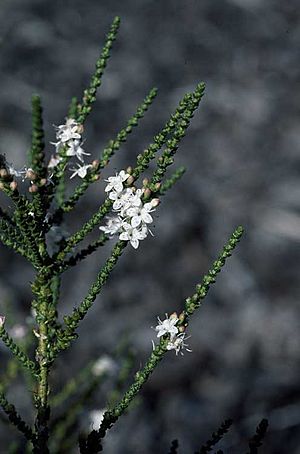Jerramungup myoporum facts for kids
Quick facts for kids Jerramungup myoporum |
|
|---|---|
 |
|
| Conservation status | |
| Scientific classification | |
| Genus: |
Myoporum
|
| Species: |
cordifolium
|
The Myoporum cordifolium, often called Jerramungup myoporum, is a unique plant found only in a small part of Western Australia. It's a type of shrub that belongs to the figwort family. This plant has thin, stiff branches and tiny, heart-shaped leaves. Both its branches and leaves are covered with small, wart-like bumps called tubercles.
Pretty white flowers with purple spots grow from where the leaves meet the stem. After the flowers, wrinkled green or brown fruits appear.
Contents
About the Jerramungup Myoporum
The Jerramungup myoporum is an upright shrub that usually grows about 1 to 1.5 meters (3 to 5 feet) tall. Its thin, stiff branches and tiny, crowded, heart-shaped leaves are covered in small, wart-like bumps. The leaves are a bit fleshy and measure about 1.3 to 3.8 millimeters (0.05 to 0.15 inches) long and 1.2 to 3.7 millimeters (0.05 to 0.15 inches) wide.
Flowers and Fruits
The flowers grow one by one where the leaves join the stem. Each flower has five sepals (small leaf-like parts that protect the bud) and five white petals that often have pink spots. These petals join at their base to form a tube. The tube is about 2.0 to 3.5 millimeters (0.08 to 0.14 inches) long, and the petal parts spread out, measuring 2.1 to 3.6 millimeters (0.08 to 0.14 inches) long. There are four stamens (the parts that produce pollen) that stick out beyond the petals.
This plant flowers from June to November. After flowering, it produces wrinkled green or brown fruits. These fruits are a type of drupe, which means they have a fleshy outer part and a hard pit inside, like a peach. They are about 1 to 2.5 millimeters (0.04 to 0.1 inches) long and slightly flat.
How it Got its Name
The Jerramungup myoporum was first officially described in 1859 by a scientist named Ferdinand von Mueller. He first called it Disoon cordifolius. Later, in 1917, another scientist, George Claridge Druce, moved it to its current group, Myoporum.
The second part of its scientific name, cordifolium, comes from two Latin words: cor (meaning "heart") and folium (meaning "leaf"). So, cordifolium simply means "with heart-shaped leaves," which perfectly describes its tiny leaves!
Where it Lives
The Jerramungup myoporum is found in a specific area of Western Australia, between the Ongerup and Jerramungup districts. It grows in different types of areas, including the Esperance Plains, Jarrah Forest, and Mallee regions. These are areas with similar plants and animals, often called "biogeographic regions." It prefers to grow in sandy or clay loam soil, which is a mix of sand, clay, and other rich soil materials.
Protecting This Plant
The Jerramungup myoporum is considered a "Threatened" plant by the Western Australian Government. This means it's at risk of disappearing and needs special protection to survive. The Australian Government also calls it "vulnerable." This shows how important it is to protect this unique plant so it can continue to grow in its natural home.


